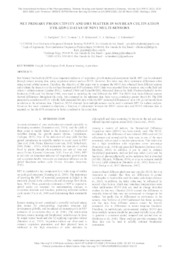Net primary productivity and dry matter in soybean cultivation utilizing datas of ndvi multi-sensors.
Net primary productivity and dry matter in soybean cultivation utilizing datas of ndvi multi-sensors.
Autoria: RODIGHERI, G.; FONTANA, D. C.; SCHAPARINI, L. P.; DALMAGO, G. A.; SCHIRMBECK, J.
Resumo: Net Primary Productivity (NPP) is an important indicator of vegetation growth status and ecosystems health. NPP can be estimated through remote sensing data, using vegetation indices such as NDVI. However, this index may show systematic differences when using several orbital sensors. Therefore, the objective of this paper was to compare the NDVI data obtained from different sensors and evaluate the impact over the soybean biomass and NPP estimates. NDVI data were recorded from 4 sensors, one on the field and others 3 orbitals sensors (Landsat 8/OLI, Sentinel 2/MSI and Terra/MODIS). Measured data on the field, Photosynthetically Active Radiation (PAR) and Dry Matter (DM), were used to modeling the total DM and also NPP. The NDVI data from different sensors showed differences throughout the cycle, but compared to the reference data there was a correlation greater than 0.84. The DM presented a correlation of 0.91 with the field measured MS data while the NPP presented differences of up to 240 gC/m²/month from in relation to the reference data. Therefore, NDVI obtained from multiple sensors can be used to estimate NPP for surface analysis. However, for more consistent evaluations, a function of adjustment between the NDVI sensor data and NDVI reference data is required, so that the NPP estimation be better correlated to the actual data.
Ano de publicação: 2020
Tipo de publicação: Artigo em anais e proceedings
Unidade: Embrapa Trigo
Palavras-chave: Agriculture, Google Earth Engine, PAR, Remote sensing
Observações
1 - Por padrão são exibidas publicações dos últimos 20 anos. Para encontrar publicações mais antigas, configure o filtro ano de publicação, colocando o ano a partir do qual você deseja encontrar publicações. O filtro está na coluna da esquerda na busca acima.
2 - Para ler algumas publicações da Embrapa (apenas as que estão em formato ePub), é necessário ter, no celular ou computador, um desses softwares gratuitos. Sistemas Android: Google Play Livros; IOS: iBooks; Windows e Linux: software Calibre.
Acesse outras publicações
Acesse a Base de Dados da Pesquisa Agropecuária (BDPA) para consultar o acervo completo das bibliotecas da Embrapa.

